Teaching Mathematics with Ephemera: John Playfair's Course Outline for Practical Mathematics
In addition to printed books and articles, correspondence, and manuscripts, the history of mathematics is documented by printed materials that were designed for temporary use. These items, called "ephemera," may be incorporated into a variety of K–16 classrooms. The article provides suggestions and resources for identifying ephemera that may be relevant to an instructor's topics or students. It also shares an example of how a historian has analyzed a piece of ephemera that is rare in print but was digitized in early 2019. Finally, a few suggestions for teaching mathematics with ephemera are listed.
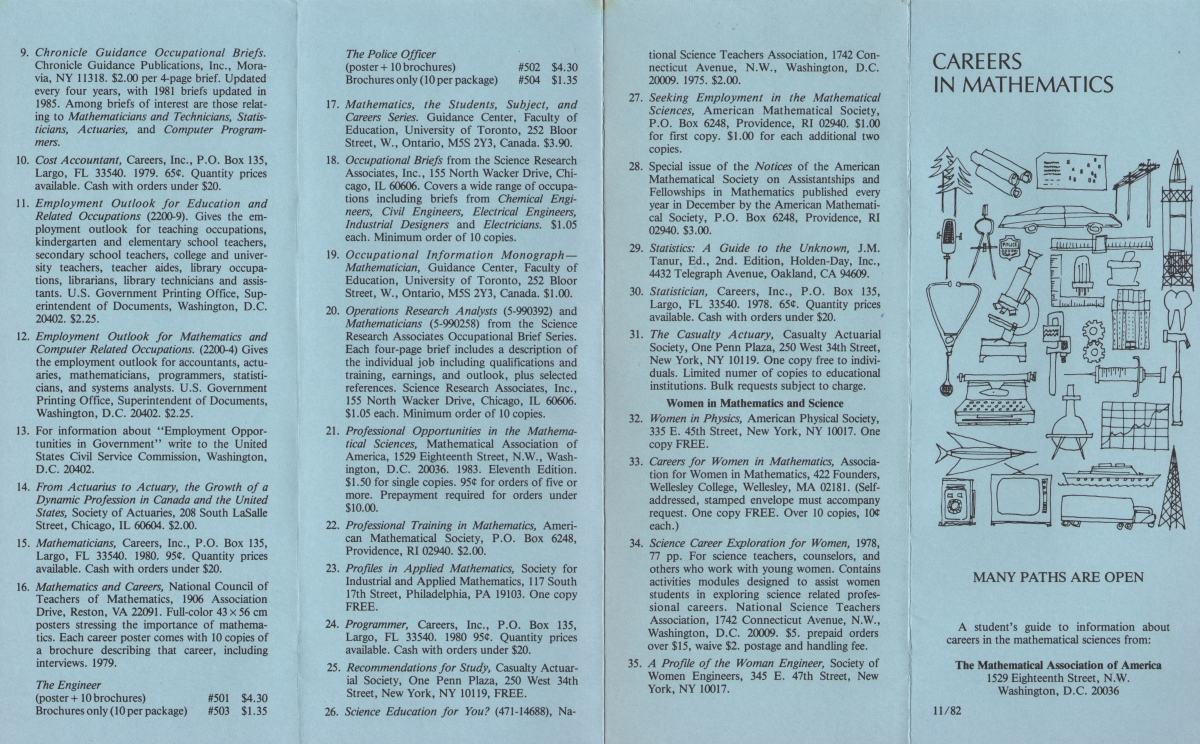
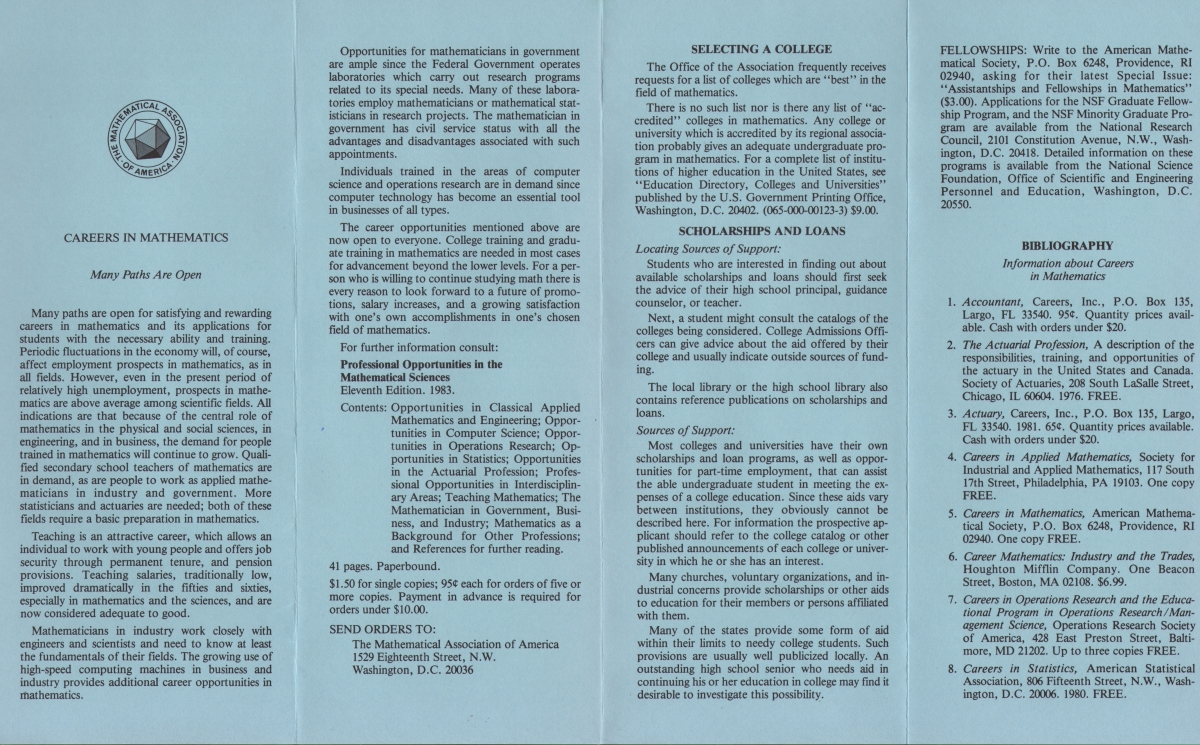
MAA brochure on careers in mathematics, ca 1982. In the author's possession.
Teaching Mathematics with Ephemera: Introduction
By "ephemera," archivists and historians mean historical printed documents that were intended for temporary use, such as:
- advertisements,
- posters,
- pamphlets,
- broadsides,
- speeches,
- trading cards,
- greeting cards,
- instruction manuals,
- sheet music,
- performance or sporting event tickets and programs,
- calendars,
- invitations, and
- paper games and toys.
Even though the long-term survival of such items is often accidental, this category of primary source has proved invaluable for cultural and social historians by providing insights into the everyday events and values of different times and places. Ephemera even boast at least one scholarly organization: The Ephemera Society of America. In large part because these materials are often colorful and engaging, schoolteachers and undergraduate history professors frequently appeal to them for classroom activities and illustrations.
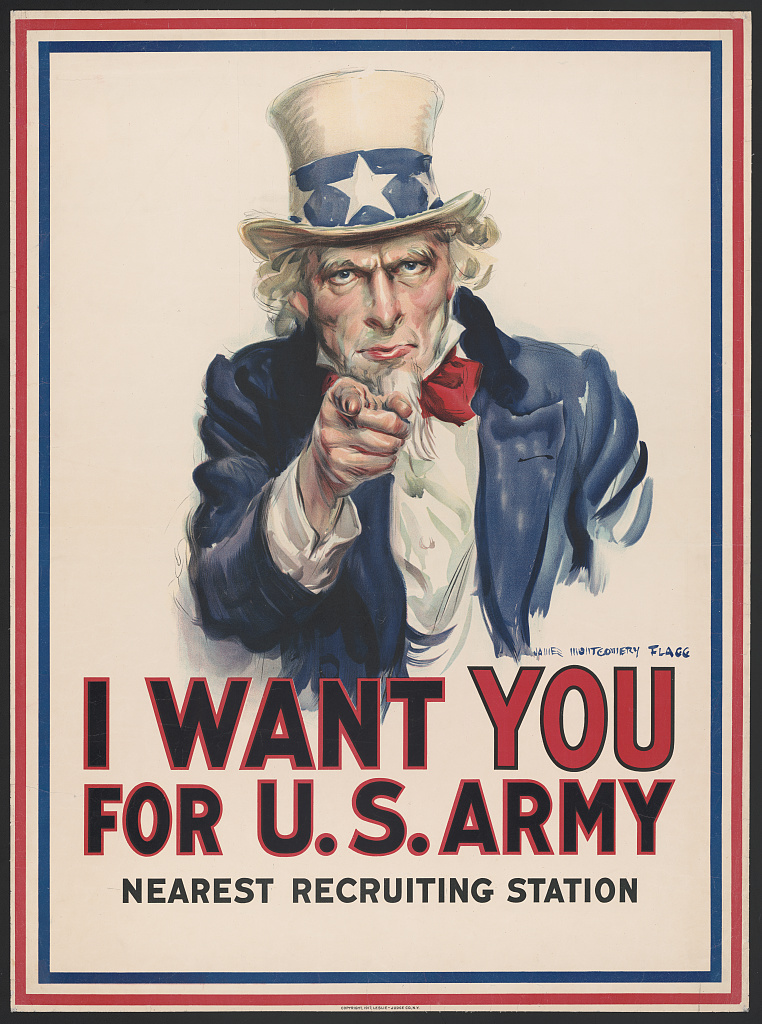
One of the most famous pieces of historical ephemera in the United States is J. M. Flagg's 1917 recruiting poster featuring Uncle Sam. Library of Congress image number LC-DIG-ppmsc-03521. No known restrictions on publication.
Mathematics has a tradition of ephemera dating back to at least the 15th century. These items are displayed in museum exhibitions and appear in history of mathematics monographs, but they can also be adapted for K–16 teaching. Indeed, mathematical ephemera already are featured in a number of MAA Convergence articles and Mathematical Treasures, including:
- Mathematical Treasure: Arbuthnot on Usefulness of Mathematics
- Mathematical Treasure: Cort's Arithmetica and Geometria
- Mathematical Treasure: Letter and Visiting Card of Augustus De Morgan
- Mathematical Treasure: A Number Line Owned by Andrew Gleason
This article will provide advice and resources for the historical analysis of ephemera, suggest some online locations instructors can search for mathematical ephemera, and evaluate an example of ephemera from the author's ongoing research into the life and career of John Playfair (1748–1819), Joint Professor of Mathematics and then Professor of Natural Philosophy at the University of Edinburgh. His 1793 pamphlet, Prospectus of a Course of Lectures on Some of the Practical Parts of the Mathematics, is not visually stunning, but an analysis of its contents sheds some light on mathematical priorities in Western Europe at the end of the 18th century.
Teaching Mathematics with Ephemera: Primary Source Analysis of Ephemera
A piece of ephemera can consist of an image, a short body of text, or a mix of image(s) and text. Thus, the techniques of historical analysis to utilize depend on what the item actually is. A drawing or photograph must be "read" visually, describing what is depicted and attempting to determine what the illustration meant to its creator and its viewers. A detailed list of each component of the image is needed in order to determine which particulars are most significant. If possible, it is helpful to ascertain the materials used to create the image. With written sources, researchers use the words of the document to identify its author's main points and to infer the author's point of view. Ephemera with a blend of images and text require a combination of the techniques for visual and written materials. In both cases, of course, those studying the source must record who made it, when, where, for whom, and for what purpose. Similarly, elaborating on historical context is vitally important to the analysis of any primary source. Further, whenever possible, primary sources should be compared to other primary sources to test the validity of the interpretations developed by researchers—do they hold up when applied to additional historical evidence? Students can also use the conclusions reached by the authors of scholarly secondary sources to corroborate their ideas. Educators at the National Archives have shared worksheets for primary source analysis that are aimed at K–12 students (NARA, 2018). While training undergraduate history majors, the author has adapted the form in (Drake and Brown, 2003) to making sense of written documents and visual sources or physical objects. See also John Lee's suggestions for classroom activities with ephemera (Lee, 2018).
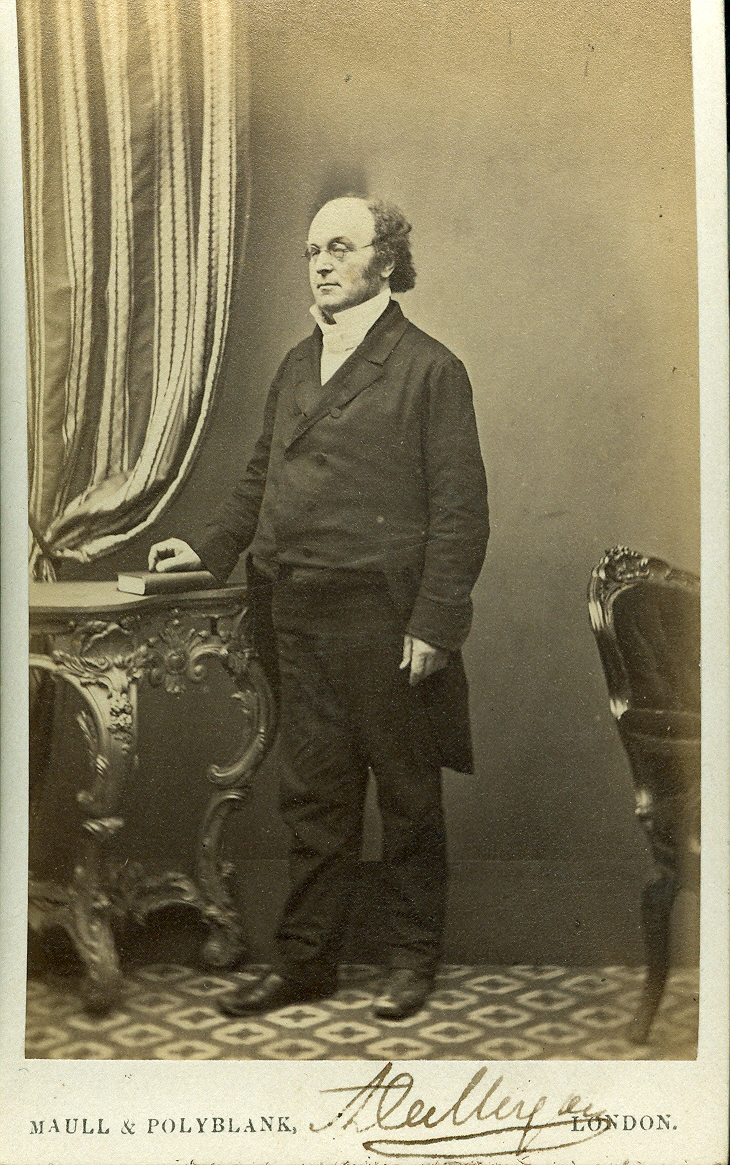
Carte de visite (visiting card) of Augustus De Morgan, signed "ADeMorgan", circa 1866.
From the collection of Dr. Sid Kolpas.
For instance, we can perform a quick analysis of Augustus De Morgan's visiting card, whose image appears in the Mathematical Treasures section of Convergence. The webpage supplies an approximate date and the information that the signature is in De Morgan's own hand. Professor Sid Kolpas also points out that the portrait was taken by the London studio of Maull & Polyblank for inclusion in a book of forty photographs and biographies of "celebrities". This reason for creating the image may explain why De Morgan's pose is formal and the furniture and setting convey the sterility of a professional business rather than, say, the informality and comfort of De Morgan's own study. Unfortunately, the dimensions of the card are not provided, but when the other information given is combined with some reading about the etiquette of calling cards in Victorian England, it appears likely that De Morgan would not have used copies of this card for his run-of-the-mill socializing. Men's cards were typically plain, with just their names and possibly their address. They were used to announce a gentleman's availability to conduct a social call that had been requested by the lady of the house; the lady could decide to receive him at that time or instruct him to return later (Cronin and Rogers, 2003; Hoppe, 2000; "Victorian Calling Card Etiquette"). They were not intended as permanent keepsakes. As an exercise for the reader, why, then, might De Morgan have wanted to distribute copies of his portrait?
Teaching Mathematics with Ephemera: Identifying Mathematical Ephemera
In addition to exploring Convergence, where might instructors locate examples of mathematical ephemera to incorporate into their mathematics classes? A great way to start is simply by keeping one's eyes open to what is already in the daily environment. Are there older flash cards, examination papers, or instruction manuals around the office? Did your institution's archives preserve copies of flyers and posters announcing events in the mathematics department? Does a colleague collect magazine or newspaper advertisements containing references to mathematics? Has your department undertaken initiatives, such as advocating for women or minorities to pursue mathematical careers or urging Americans to convert to the metric system, that might have left mailings or promotional items behind in a file cabinet or drawer? Have you seen broadsides, lecture tickets, or report cards reproduced in history of mathematics scholarship? Has an overseas colleague sent a letter with an interesting postmark or stamp? Do students have memorabilia at home that connects with the history of mathematics—perhaps an instruction manual for a slide rule or early handheld calculator? If you prefer not to wait for a serendipitous discovery, following are some suggestions for locating online resources related to a few popular categories of ephemera.

Stamps honoring Fr. Angelo Secchi, who founded astronomical spectroscopy, and Maria Agnesi, female mathematician and textbook author, issued in 2018 by Vatican City. Image provided in 6 September 2018 press release.
Stamps: Philately might be one of the most well-known hobbies of mathematicians looking for engaging ways to tell stories about the discipline's history. Philamat, which appears to be the largest digital collection of postage stamps depicting historical mathematicians or achievements, is a joint effort of Sociedade Portuguesa de Matemática and the British Society for the History of Mathematics. Individual sites have been assembled by Jim Kuzmanovich and Jeff Miller.
Advertisements: Twentieth-century magazines, particularly those focused on science and engineering, frequently carried advertisements for slide rules, computers, and calculators, among other mathematical tools. These can illustrate historic technology to students, as well as cultural attitudes toward these objects and perceptions of gender, race, and class. University and public libraries may continue to maintain print runs for browsing; perusing digital copies for items that are not articles can be more complicated since libraries and contractors conducting large-scale scanning projects have not always included front and end matter, as well as other pages that were not a part of text articles. Some advertisements may already have been harvested by museum curators for online exhibitions, such as the Smithsonian's National Museum of American History's 2014 show, The Early Sixties: American Science.
General Collections of Ephemera: A number of archival, library, and museum websites have sections for ephemera that may be searched for mathematical items. For example, a search of the Library of Congress's collection, "Printed Ephemera: Three Centuries of Broadsides and other Printed Ephemera," returns 114 results, beginning with a self-promoter's claim to have proved that one side and one angle are sufficient to determine the sides and angles of a triangle. Many of the other leaflets are educational announcements and materials. Remember also to inquire at local archives and history societies. Smaller or specialized institutions with mathematical ephemera include: Historic New England, the Naval History and Heritage Command, and the California State Library.
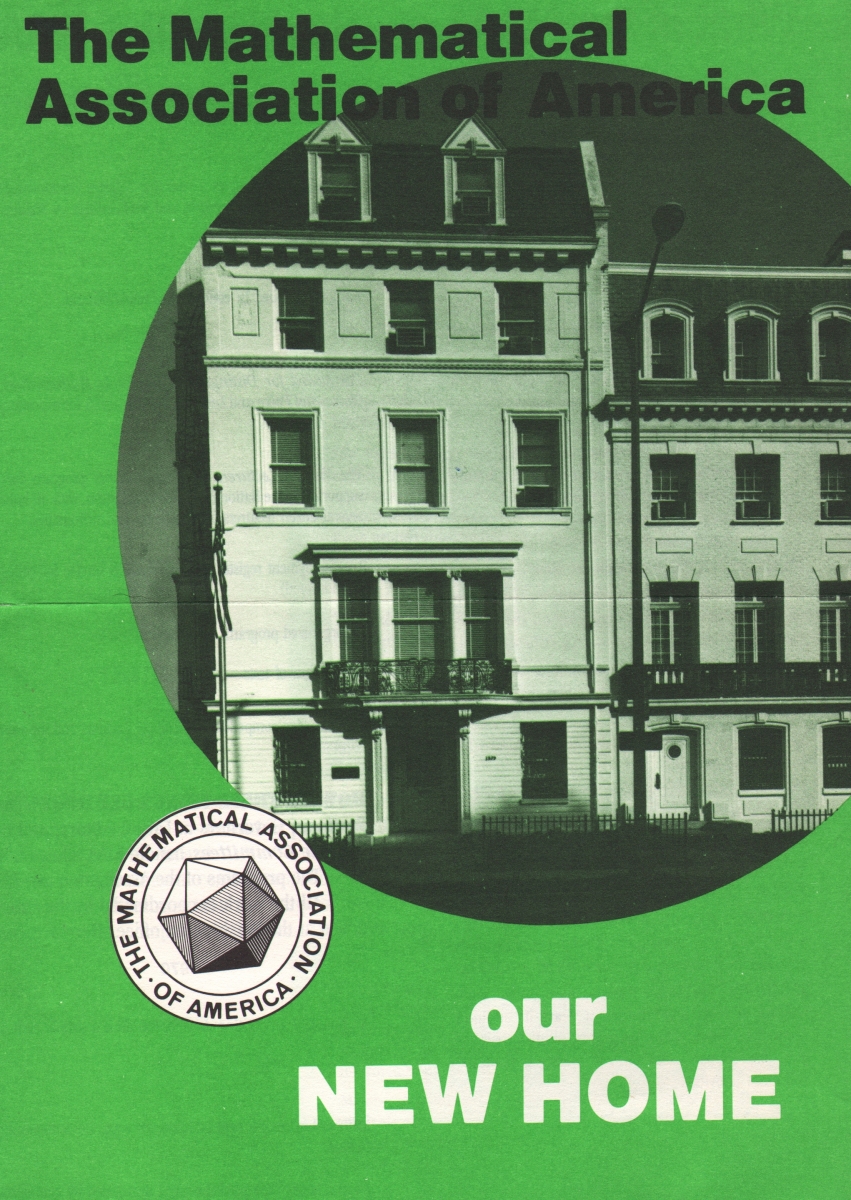
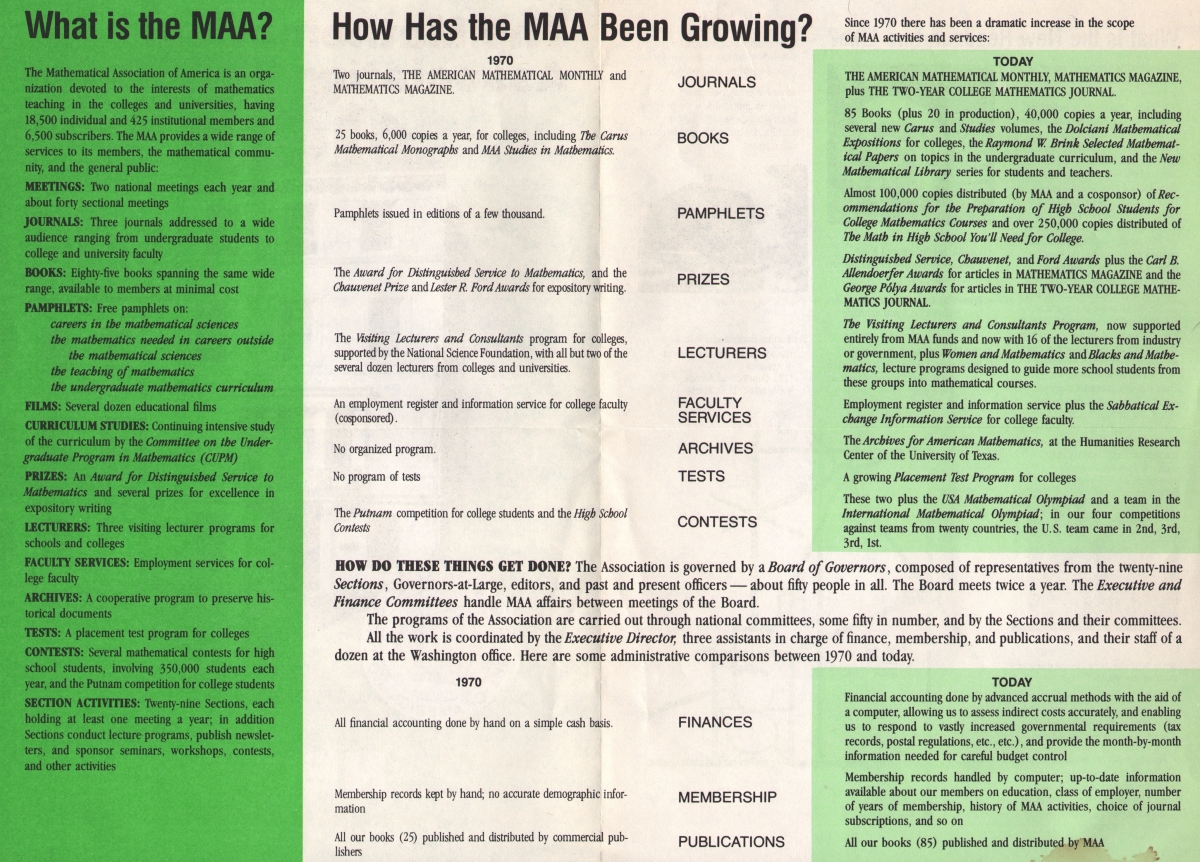

Informational brochure about the MAA and its then-new headquarters in Washington, DC, ca 1970. In the possession of the author.
Teaching Mathematics with Ephemera: Who Was John Playfair?
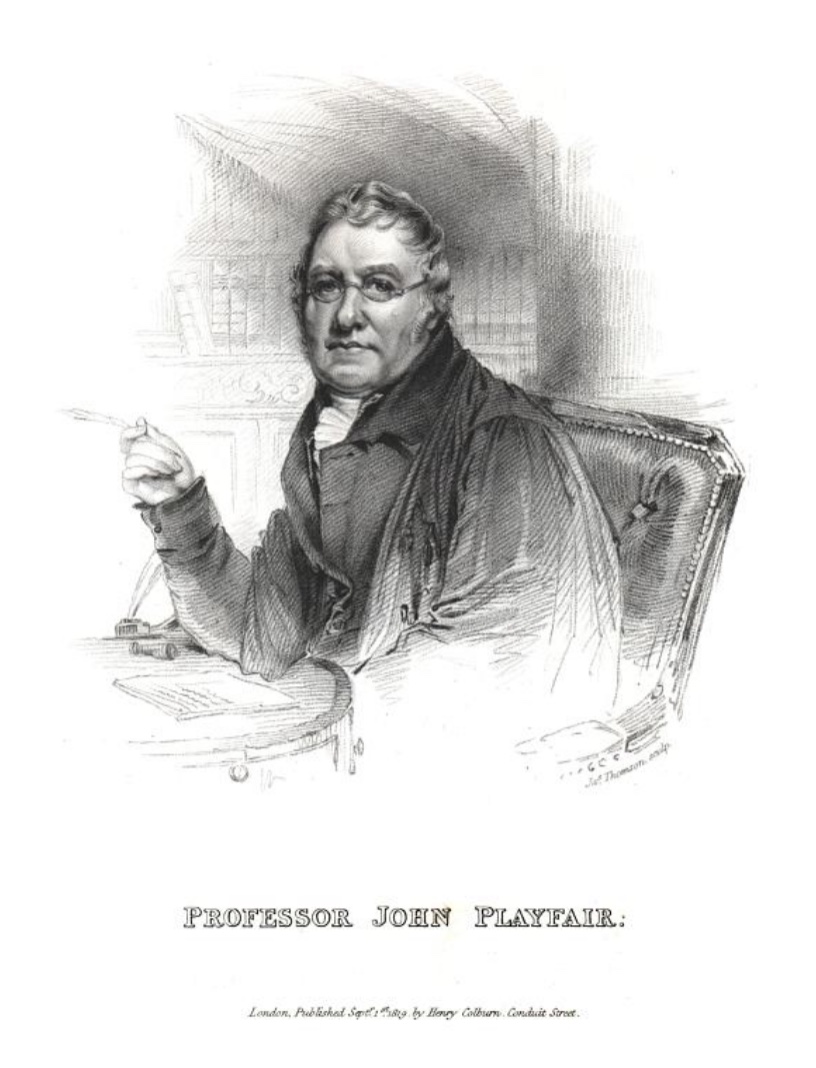
John Playfair in 1819. A print engraving by American mathematics textbook publisher James Thomson (1789–1850), based on an etching made by William Nicholson. Courtesy of Scientific Identity Collection, Dibner Library, Smithsonian Institution Libraries, Washington, DC.
John Playfair (1748–1819) is best known among mathematicians for his 1795 textbook, Elements of Geometry, and among historians of science as one of the founders of geology as a formal discipline. He was born on March 10, 1748, in Liff and Benvie, Scotland, the eldest son of what eventually was seven siblings who lived to adulthood. His father was the Church of Scotland minister in these parishes. Playfair matriculated at the University of St. Andrews in 1762, filling in for the ailing natural philosophy professor while still a student and graduating M.A. in 1765. He remained in St. Andrews long enough to qualify for licensure as clergy in 1770. He became financially responsible for his family when his father died in 1772, and he succeeded his father as minister to Liff and Benvie in 1773 (Ackerberg-Hastings, 2005).
Even though his religious and family duties were time-consuming, Playfair was simultaneously making himself known to Scotland's intellectuals—this period of the late Scottish Enlightenment was an era of great energy in the areas of natural and moral philosophy as well as a time of preparation for industrial take-off (Daiches, Jones, and Jones, 1986; Buchan, 2003). In 1774, he assisted Astronomer Royal Nevil Maskelyne with observations on a nearby mountain, Schehallion. Maskelyne sponsored Playfair's first scientific paper, "On the Arithmetic of Impossible Quantities," which was delivered to the Royal Society of London in 1778. Playfair resigned his parishes in 1782 when he was hired to tutor aristocratic brothers who would grow up to be Member of Parliament Robert Ferguson and General Sir Ronald Craufurd Ferguson. This position both better matched his abilities and allowed him more time to pursue his interests. In 1783, he became a founding member of the Royal Society of Edinburgh. In 1785, he finally was appointed to one of the few academic positions in mathematics in the United Kingdom, Joint Professor of Mathematics at the University of Edinburgh.
Playfair began publishing in Transactions of the Royal Society of Edinburgh in 1788, completing six articles before he became the journal's editor in 1798, succeeding John Robison. He wrote eight more articles during his term. His first book was 1795's Elements of Geometry, a textbook designed to update Robert Simson's 1756 The Elements of Euclid. A close friend of James Hutton, in 1802 he completed an explanation and expansion of Hutton's ideas (including the great age of the earth, the belief that most changes in geological structures were caused by heat, and the very slow—or "uniformitarian"—rate of those changes) that was published as Illustrations of the Huttonian Theory of the Earth. In 1804, Playfair began to contribute to Edinburgh Review, a new journal that quickly became famous for its Whiggish politics. Because the articles were unsigned, there is no definitive count of those that can be attributed to Playfair. He is the likely author of about 60 pieces. His submissions were often as much general essays about the state of mathematics, natural philosophy, scholarship on India, women writers, and other topics, as they were detailed examinations of the books they ostensibly reviewed (Ackerberg-Hastings, 2008). Playfair wrote one more textbook, the two-volume Outlines of Natural Philosophy, which appeared in 1812 and 1814. His final major publication summarized his understanding of the history of science in Europe, "Dissertation Second: On the Progress of Mathematical and Physical Science Since the Revival of Letters in Europe," which appeared in a supplement to Encyclopaedia Britannica in 1816. He was ill for a number of months before he died at home in Burntisland in Fife on July 19, 1819.
Playfair never married nor fathered children, but his mother and sisters remained in his household throughout his lifetime. After his brother James, an architect, died in 1794, Playfair saw to the education of James's sons, James and William Henry. William Henry Playfair followed his father to become a prominent architect, designing much of Edinburgh's "New Town" as well as the monument to Playfair that stands on Calton Hill. The descendants of another brother, Robert, apparently ended up in Canada, while a third brother, William, was notoriously mixed up in multiple careers and schemes but found time to invent graphical methods in statistics (Playfair, 2005).
Teaching Mathematics with Ephemera: Prospectus of a Course of Lectures on Some of the Practical Parts of the Mathematics
Playfair's publication record was extensive but largely expository in nature. Perhaps it is not surprising that a man who wrote out and read his classroom lectures apparently also approached his writing career as an ongoing opportunity to inform and educate. The pamphlet we will explore here fit well within these overall tendencies.
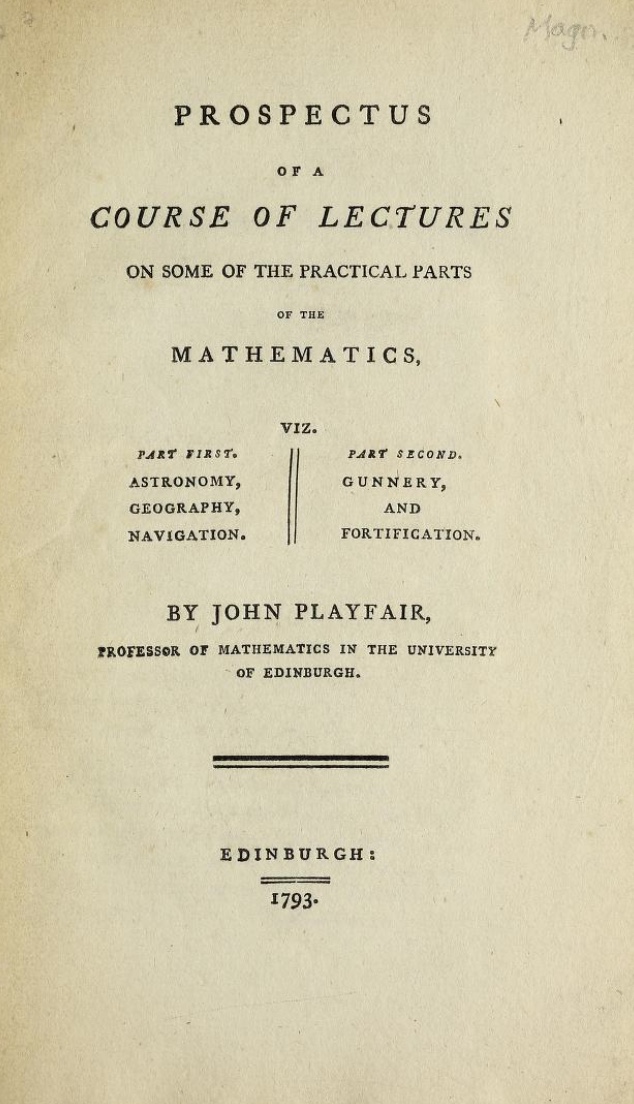
Title page of Playfair's 1793 pamphlet. Courtesy of Dibner Library, Smithsonian Institution Libraries, Washington, DC.
Prospectus of a Course of Lectures on Some of the Practical Parts of the Mathematics appeared in 1793, eight years into the professorship Playfair shared with Adam Ferguson, who remained too ill to conduct any teaching. No publisher is mentioned in the volume's slim nineteen pages, but the design of the title page is similar to designs employed by Bell & Bradfute, the increasingly prominent Edinburgh firm that in 1795 published Elements of Geometry. Although the pamphlet was professionally published, it likely was intended only for temporary use. It is not clear how many copies were made or whether they were sold or given away, but as few as eight copies remain in existence today, suggesting that few readers valued the pamphlet enough to retain it. No announcements of Prospectus's publication or evidence that Playfair actually held the course—at the University of Edinburgh, within one of the intellectual and social clubs in the city at the time, or for the general public—have been found, either. A best guess is that Playfair was gauging interest in a series of lectures or a book and either decided there was none or became involved in other projects.
The booklet is simply a detailed table of contents. As shown on the title page, Playfair announced an intention to lecture on five subjects: astronomy, geography, navigation, gunnery, and fortification. Geography was divided into astronomical geography and physical geography. While most mathematicians and educators shared a sense of how practical mathematics was defined (as the mathematical concepts utilized in the practices of people such as builders and surveyors), they had not reached consensus on the specific subjects included in practical mathematics. Those chosen by Playfair appeared in other practical mathematics textbooks, but no other textbook had exactly the same selection of subjects. Playfair's attention to physical geography was particularly unusual for a work of mathematics—indeed, the content he proposed to present was descriptive rather than mathematical—but it almost certainly arose from his interest in geology.
Within Prospectus, geography received the most importance in terms of numbers of proposed lecture topics. Astronomical geography was divided into five sections containing 40 topics, and physical geography had ten sections with 112 topics. Including the introduction, the subject had 155 topics in all. For comparison, astronomy had 14 sections with a total of 91 topics; navigation had six sections with 39 topics; gunnery included four sections with 40 topics; and fortification contained four sections with 42 topics. Thus, physical geography and astronomy were weighted almost equally. The two subjects together were to take up about half of the course, with the other half essentially balanced between the other four subjects.
The first section under the subject of astronomy illustrates what the text of the entire pamphlet looked like:
General view of the Phœnomena of the Heavens.—Apparent Motion of the fixed Stars, of the Sun, Moon, Planets, Satellites of the Planets, Comets.—To have a more accurate knowledge of these, the Doctrine of the Sphere must be explained.—Definitions.—Poles.—Primary Circles, viz. Equator, Parallels; Hour Circles or Meridians, Ecliptic, Tropics.—Arches of the Equator measured by Degrees or by Hours.—Conversion of one of these measures into the other.
Secondary Circles, Horizon, Verticals, &c.—Latitude and Longitude.—Right Ascension and Delination of the Stars.—Altitude, Azimuth of Stars.—Zenith of a Place; Latitude of a Place defined.—Elevation of the Pole (Playfair, 1793, pp. 1–2).
This analysis is conducted in more detail in (Ackerberg-Hastings, 2018). Even though the topic headings provide sparse information about how Playfair understood or taught them, they do suggest some of the priorities that guided this professor throughout his career. These will be discussed briefly on the next page, along with a few suggestions for using Prospectus—and other pieces of ephemera that are essentially outlines—in classrooms.
Teaching Mathematics with Ephemera: Teaching the Prospectus
The themes that emerge from the projected lecture topics are one of the most notable features of Prospectus. For example, Playfair emphasized the use of mathematical instruments throughout the document. In the astronomy lectures, he planned to recommend the use of the telescope, astronomical quadrant, Hadley's quadrant, micrometer, gnomon, sundial, clock, and transit telescope. Under physical geography, he referred to the barometer, hygrometer, and themometer, which were all instruments that early geologists were taking into the field for making measurements. In the sections dealing with navigation, he mentioned the log, mariner's compass, rhumb-line, and compass, and he again intended to discuss Hadley's quadrant.
Another theme that ran through both the Prospectus and Playfair's entire career was his interest in the history of science and mathematics. Specifically, he planned in the lectures to talk about some of the secondary sources he was reading about mathematics and astronomy in India. He also intended to introduce the general subject of geography with a review of its history. A third theme is the large number of recent or open questions Playfair expected to share with his audience, including: parallax, adjustments for differences between real and apparent motion, the dimensions of the solar system, the figure of the Earth, and determination of longitude. Major research achievements explaining many of these phenomena, such as Laplace's Mécanique céleste, remained a few years in the future when Playfair put together his outline in 1793. Staff at the Dibner Library, Smithsonian Institution Libraries, have digitized their copy of Prospectus so that you may explore the pamphlet yourself and develop additional themes of relevance to your own students and subjects.
Considering how the content of a piece of ephemera relates to the topics you teach is one way to bring an example such as Prospectus into a mathematics classroom. The format of Prospectus and similar documents, an extended outline, suggests additional possibilities for classroom use:
- Students may evaluate the overall structure, content, and approach represented by a course outline. How effective do they think it might have been at promoting teaching and learning? How could they apply what they found in their analysis to planning out a class period or entire course that they might teach? How might they design a curriculum or articulate standards?
- Instructors might pull out a specific definition from an outline and ask students to research whether that definition remains in use or whether understandings of the term being defined have changed over time.
- As with any historical document, an extended outline reflects the values of its creator. According to Prospectus, what mattered to Playfair? How do his beliefs about which subjects and concepts were essential compare to the values we assume are widespread in the present? Are the convictions we accept as universal truly as widespread as we think they are?
These sorts of activities might be most useful in mathematics education classes, upper-level courses that orient students to particular fields within the mathematics major, and senior capstones. This category of material, though, is only one form of the wide range of mathematical ephemera that exist and thus represents only one set of opportunities among the many possible classroom applications of these primary sources. As you review all of the sections of this article, feel free to let your imagination roam!
Teaching Mathematics with Ephemera: Bibliography and About the Author
Ackerberg-Hastings, Amy. "John Playfair in Letters." In Proceedings of the Canadian Society for History and Philosophy of Mathematics, edited by Antonella Cupillari, 9–18. Vol. 18, Thirty-First Annual Meeting, 4–6 June 2005.
Ackerberg-Hastings, Amy. "John Playfair on British Decline in Mathematics," BSHM Bulletin 23, no. 2 (2008): 81–95.
Ackerberg-Hastings, Amy. "John Playfair's Approach to 'the Practical Parts of the Mathematics'." In Research in History and Philosophy of Mathematics: The CSHPM 2017 Annual Meeting in Toronto, Ontario, edited by Maria Zack and Dirk Schlimm, 91–107. Proceedings of the Canadian Society for History and Philosophy of Mathematics. Birkhäuser, 2018.
Buchan, James. Crowded with Genius: The Scottish Enlightenment: Edinburgh's Moment of the Mind. New York: Harper, 2003.
California State Library. "California Ephemera." Last updated in 2019. http://library.ca.gov/california-history/ephemera/.
Cronin, Blaise, and Yvonne Rogers. "From Victorian Visiting Card to vCard: The Evolution of a Communicative Genre." Journal of Information Science 29, no. 1 (2003): 65–68.
Daiches, David, Peter Jones, and Jean Jones, eds. A Hotbed of Genius: The Scottish Enlightenment 1730-1790. Edinburgh: University Press, 1986.
Drake, Frederick D., and Sarah Drake Brown. "A Systematic Approach to Improve Students' Historical Thinking." The History Teacher 36, no. 4 (2003): 465–489.
The Ephemera Society of America. 2013. http://www.ephemerasociety.org/. (Clicking on "What is Ephemera?" at the bottom of the page brings up a list of categories of ephemera, many of which have descriptive paragraphs or short essays as well as illustrations.)
Historic New England. "Collections Search." Last updated in 2018. https://www.historicnewengland.org/explore/collections-access/.
Hoppe, Michelle. "Calling Cards and the Etiquette of Paying Calls." Literary Liaisons. 2000. http://www.literary-liaisons.com/article026.html.
Kolpas, Sid. "Antiquarian Texts & Ephemera = Excitement & Enrichment." Ephemera Journal 12, no. 4 (1994): 26–27.
Kuzmanovich, Jim. "Mathematical Stamp Collecting." Wake Forest University. ca 2000. http://users.wfu.edu/kuz/Stamps/stamppage.htm.
Lee, John, ed. Historical Ephemera. 2016. http://historicalephemera.com/.
Lee, John. "Using Historical Ephemera in the Classroom." TeachingHistory.org. 2018. https://www.teachinghistory.org/teaching-materials/teaching-guides/25028.
Library of Congress. "Printed Ephemera: Three Centuries of Broadsides and other Printed Ephemera." Digital Collections. https://www.loc.gov/collections/broadsides-and-other-printed-ephemera/about-this-collection/.
Miller, Jeff. "Images of Mathematicians on Postage Stamps." Last updated in 2018. http://jeff560.tripod.com/stamps.html.
National Archives and Records Administration. "Document Analysis Worksheets." Educator Resources. Last updated December 18, 2018. https://www.archives.gov/education/lessons/worksheets.
Naval History and Heritage Command. "Our Collections." https://www.history.navy.mil/our-collections.html.
Playfair, John. Prospectus of a Course of Lectures on Some of the Practical Parts of the Mathematics. Edinburgh, 1793.
Playfair, William. The Commercial and Political Atlas and Statistical Breviary. 1786. Reprint edited and introduced by Howard Wainer and Ian Spence. New York: Cambridge University Press, 2005.
Smithsonian's National Museum of American History. The Early Sixties: American Science. 2014. http://americanhistory.si.edu/early-sixties-american-science.
Sociedade Portuguesa de Matemática and the British Society for the History of Mathematics. Philamat: Mathematics—A Philatelic History. 2015. http://www.mathematicalstamps.eu/index. (Toggle between the Portuguese and English languages by clicking on the circle to the right of "Contactos".)
"Victorian Calling Card Etiquette." All Things Victorian. 1997. http://www.avictorian.com/social_rituals.html.
About the Author
Amy Ackerberg-Hastings co-edits MAA Convergence, the Canadian Society for History and Philosophy of Mathematics (CSHPM) Bulletin, and the CSHPM Notes column in Canadian Mathematical Society Notes. She has over a decade of experience with teaching undergraduate history majors the principles and methods of historical research and mentoring them through preparation of their senior original research project. She has also worked in the mathematics collections at the Smithsonian's National Museum of American History (NMAH) and held a fellowship in NMAH's Dibner Library. Her PhD from Iowa State University is in the history of science and technology.